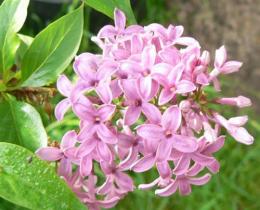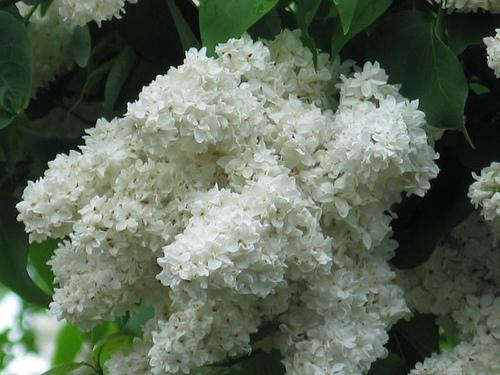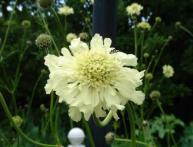This magical Chinese lilac

A modest bush plant called lilac has received very wide distribution and great universal love in our country. Tiny lilac flowers with a chic, intoxicating aroma delight people in the spring, filling the air with a heady sense of anticipation of summer.
Content:
Chinese lilac
Lilac is the only ornamental shrub that is not only still cultivated, but also has more than 30 species in its family. This wonderful plant gets its name from the Latin word “syringa”, which means tube, because the flowers of this shrub are shaped very much like tiny tubes.
However, there is another version according to which the name of these marvelous flowers is given in honor of the nymph Syringa, who was turned into a reed. It was from this reed that the forest god Pan made the Syrinx pipe.
One of the representatives of lilac is Chinese lilac. Surprisingly, it was not discovered in China, as one might think from the name, but in France. This is a natural hybrid, the characteristic feature of which is that the inflorescence is formed from several lateral buds. The color is unusually lush and beautiful, which is amazing, considering that the size of the bush barely reaches 3 m.
Location and growing conditions
- Chinese lilac does not differ in the whimsical conditions for growth, but most of all it loves loamy, alkaline and fresh soils.
- The bush is very tolerant of frost, which makes it possible to grow it in our climate. Chinese lilac tolerates urban climate, wind, and wintering well, which is surprising, given its elegance and fragility in appearance.
- However, the shrub loves good lighting and quality watering.
- It is best to irrigate the plant frequently during flowering, and in the summer only on particularly hot days.
Landing

Most suitable landing period bush season is from mid-June to September. If planted at another time, the plant does not take root well, and does not produce growth for the first couple of years. If several bushes are planted at once, then a distance of 2-3 meters should be maintained between them for better development of the root system.
Planting pits for Chinese lilacs should be 50*50*50 cm in size. If the soil is not fertile or sandier than the plant requires, then the dimensions are increased to 100*100*100 cm. In this case, the bottom of the pit is filled with a mixture for feeding the bush, consisting mostly from compost, humus, wood ash and superphosphate.
The last component is necessary for acidifying too alkaline soils, and when using it, it is advisable to double the amount of wood ash. The edges of the pit should be vertical, as required by the planting conditions of this type of plant.
It is advisable to carry out the planting itself in the evening or in cloudy weather. In this case, diseased shoots should be removed from the root system or, if there are none, the roots should be streamlined by pruning them. The bush is installed clearly in the center, then the substrate is poured evenly and the lilacs are buried.
Shrub care
- After planting, the plant must be watered generously.When all the water has been absorbed, you need to sprinkle the planting site with rotted leaves, peat or humus.
- During the first few years of Chinese lilac growth, you don’t need to apply fertilizer to the bush. However, you can “feed” the soil with nitrogen already in the second year after planting. Organic fertilizers are considered more favorable for plant development and growth. It is best to loosen the soil under the bush 3-4 times per season.
- In order for the bush to please with abundant flowering and a beautiful appearance, it must be systematically pruned. But it is worth remembering that for the first 2-3 years after planting, Chinese lilac grows weakly and only adapts to the new environment, and therefore does not yet need pruning. But already in 3-4 years, the lilac forms a dense skeleton of 8-10 strong branches, which forms the basis of the entire bush.
- in spring before flowering begins it is necessary to find 5-10 of the strongest branches, in addition to them, all side branches are cut off. Thinning and sanitary pruning of shrubs should be done in early spring so as not to disturb the tree and not disturb the beauty of flowering. However, if there is an urgent need, you can prune the branches even during the growing season.
To make bouquets, it is useful to cut up to 2-3 shoots. This stimulates the color of the remaining flowers and even provokes the release of new color. The bouquet itself lasts longer if you cut it early in the morning and split the end of the branch.
It must be remembered that young seedlings need protection in winter, so they need to be covered with peat and dry foliage with a layer of up to 10 cm.
A little interesting about lilac

- Did you know that this incredibly beautiful and lush bush with an intoxicating aroma belongs to the Olive family? And in England, a bouquet of lilacs is given as a sign of refusal to the unlucky groom. In Eastern countries, lilac generally means parting, which does not at all fit with our perception of this plant.
- In astrology this beautiful flower attached to the sign of Taurus. And he himself and the shoots of this bush are even depicted on the coat of arms of one of the cities of Latvia, Sigurd.
- The popularity of lilac is also proven by the fact that despite the early age of the shrub (only about five centuries), it already has many more species than other ornamental shrubs. In terms of popularity in terms of the number of species, lilacs are second only to roses and rhododendrons.
- There are also several signs associated with lilacs. For example, if you find a flower with five or more petals, this promises good luck. There is also a version that when you find such a flower, you need to eat it and make a wish that will certainly come true. If you find a three-petalled flower, then you need to get rid of it as soon as possible, since it can bring discord and trouble.
Chinese lilac is certainly very beautiful bush, which can delight not only as a bouquet at home, filling the entire living space with a special, already full-fledged spring atmosphere. This shrub also looks great in summer cottages and as a hedge. This is probably the explanation for the great popularity of this shrub in many countries.
Watch an educational video about Chinese lilac:
Interesting information about the vegetable garden











Comments
I have this kind of lilac growing (white), but it hasn’t bloomed for several years. I can't figure out what the reason is.